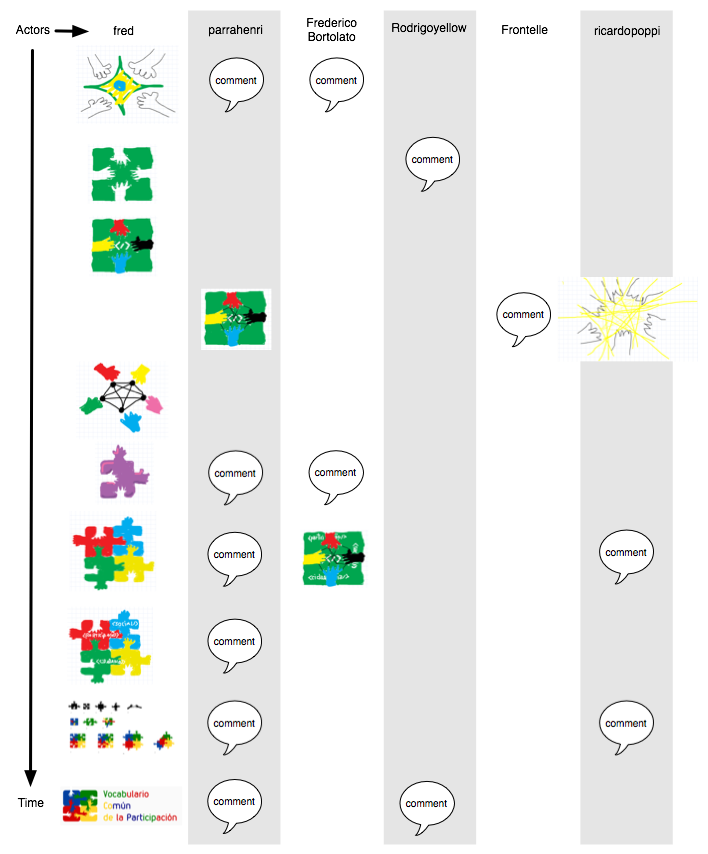Uma logo projetada por várias pessoas, não necessariamente designer profissionais, numa plataforma colaborativa, acontece mais ou menos assim:
Month: January 2013
Digging a hole in the ground
Niall Hedderman, 2012
The design world is about to undergo its biggest change since the industrial revolution. The advent of domestic manufacturing, such as 3D printing, and the rise of online culture are about to give ordinary people the ability to produce and share sophisticated physical objects on a massive scale.
For only the third time in human history, we may have the opportunity to completely change the way we relate to the design of physical objects. The creative amateur may no longer be limited to making one-off designs for themselves, nor will they be restricted to consuming products designed by others. This will come as a direct challenge to people who believe that only a few precious things are designed and that everything else just gets made.
FAB LAB Brasil
Um Fab Lab (abreviação de fabrication laboratory) é um laboratório de fabricação totalmente equipado que dá a todos, desde crianças a profissionais e empresas, a capacidade de transformar suas idéias e conceitos em realidade. O objetivo é que se possa fazer quase tudo dentro deste espaço visando o desenvolvimento social e econômico, seja a nível individual ou comunitário.
O Fab Lab Brasil em si não é um laboratório físico mas sim um ponto de encontro entre todos os Fab Labs brasileiros: os já existentes, os que estão em vias de existir e os que ainda estão em fase de projeto. A idéia é que todos possam ajudar a fortalecê-lo e a potencializá-lo.
Veja mais informações aqui: FAB LAB BRASIL.
Entrevista com Bas van Abel
Bas van Abel on Open Design on Vimeo on Vimeo
Editor do livro Open Design Now e diretor do FabLab Amsterdam.
The Design Journal issue on Open Design
Design in the Netherlands has been able to progress because of arelatively open-minded culture. The Netherlands is a small country with a comparatively high number of designers. In general, most tend not to be highly specialized or tied to industry; they cannot limit themselves to one area and must be open to other disciplines inside and outside of the design field (van Abel et al, 2011: 13). This results in a natural eagerness to share and cooperate, making the Dutch context interesting from the perspective of open design.
The Economics of Giving Things Away
During a two-month stay in Berlin I was meeting eleven leading figures from of the open scene talking about copyright, networks and the beginnings of a new economy in design. The outcome of these interviews is a booklet that should be an introduction to Open Design as well as a stimulation of further discussions.
via Make Design Open.
Open Design Consulting
Pesquisa de Asta Fjeldsted:
Open source promotes free redistribution and access to an end product’s design and implementation details. This notion of “giving it away for free” has ignited many thoughts and contemplation on how it can lead to a successful business. Within software this has proven to be a lucrative and efficient way to develop products and sustain a business, but what happens when this approach is used on physical products?
Curso de verão sobre fabricação digital em Portugal
STTF2013 is intended for Master and PhD students, researchers, and professionals from STS, Product and Service Design, Social Sciences and Humanities, Architecture and Engineering, Communication and Media, Environmental Studies, Economics and Management, Computer Sciences, and others. Regardless of individual experience, technical skills, or knowledge of social methodologies, everyone will have the opportunity to work together in sociotechnical processes of design, construction and discussion of concrete objects, with all four pillars of sustainability as background.
From codesign and scenario workshops, to rapid prototyping and open production exercises, STTF2013 participants will be encouraged to develop a new set of skills to deal with subjects such as digital fabrication, 3D simulation and printing, new sustainable materials, adaptable and interactive systems, participatory innovation, DIY creativity and new making cultures, appropriated and value sensitive artifacts, societal implications of technology, qualitative social methods, or critical science and technology studies.
Design Livre e Cultura Colaborativa
Palestra no 4o. EBAI sobre meu doutorado na Holanda, a Plataforma Corais e os UXCards: Design Livre e Cultura Colaborativa
Pedagogia do Design Livre
Na minha palestra do EBAI fiz a analogia com o cinto de utilidades do Batman. O Batman só coloca no cinto os gadgets que ele sabe usar porque ele sabe que, quando surgir a oportunidade de usar, não haverá tempo pra aprender. Essa transição do conhecimento do livro ao cinto é carente de mediação. Os profissionais experientes dizem que não tem segredo: basta tentar. Mas não é sempre que se pode tentar novos conhecimentos, dada as limitações de tempo e risco dos projetos.
Usabilidoido : Pedagogia do Design Livre.



![Design Livre e Cultura Colaborativa [ Palestras ]](https://designlivre.org/wp-content/uploads/2013/01/ebai2011-palestra-7-thumb-700x329-197.jpg)
![Pedagogia do Design Livre [ Design de Interação ]](https://designlivre.org/wp-content/uploads/2013/01/batman_methods_thumb.png)